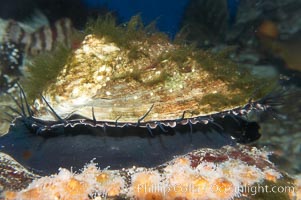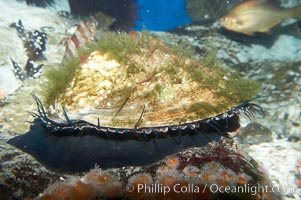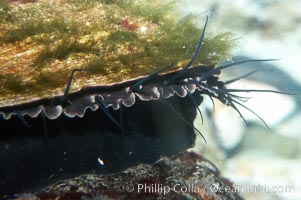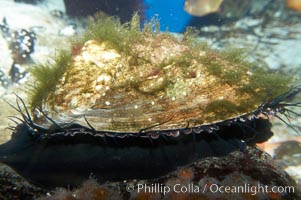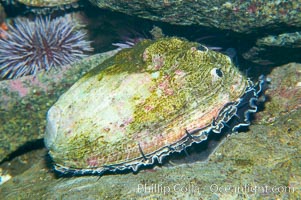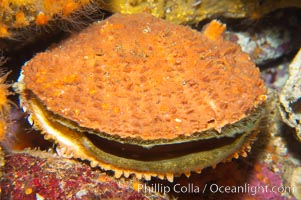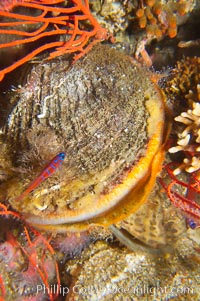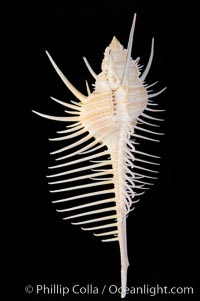
Venus comb murex. Scientists speculate that the distinctively long and narrow spines are a protection against fish and other mollusks and prevent the mollusk from sinking into the soft, sandy mud where it is commonly found.
Species: Venus comb murex, Murex pecten
Image ID: 12971
Species: Venus comb murex, Murex pecten
Image ID: 12971
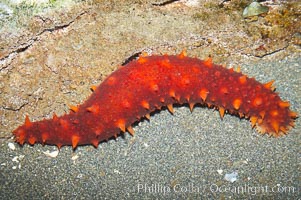
California sea cucumber. Sea cucumbers are related to sea stars and sea urchins. The sharp looking spines are soft to the touch and disappear into the skin when disturbed. If this visual defense doesnt work, the sea cucumber will expel its respiratory system. When this occurs in the wild it can regrow the lost organs.
Species: California sea cucumber, Parastichopus californicus
Image ID: 13732
Species: California sea cucumber, Parastichopus californicus
Image ID: 13732
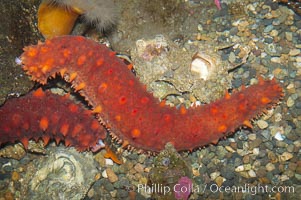
California sea cucumber. Sea cucumbers are related to sea stars and sea urchins. The sharp looking spines are soft to the touch and disappear into the skin when disturbed. If this visual defense doesnt work, the sea cucumber will expel its respiratory system. When this occurs in the wild it can regrow the lost organs.
Species: California sea cucumber, Parastichopus californicus
Image ID: 13733
Species: California sea cucumber, Parastichopus californicus
Image ID: 13733
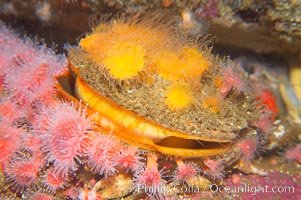
Rock scallop surrounded by strawberry anemones.
Species: Rock scallop, Corynactis californica, Crassedoma giganteum
Image ID: 14006
Species: Rock scallop, Corynactis californica, Crassedoma giganteum
Image ID: 14006
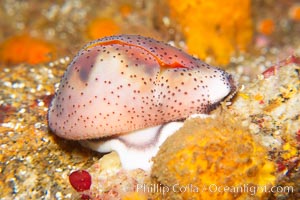
Chestnut cowry, mantle exposed to completely cover the hard exterior shell.
Species: Chestnut cowrie, Date cowrie, Cypraea spadicea
Image ID: 14020
Species: Chestnut cowrie, Date cowrie, Cypraea spadicea
Image ID: 14020
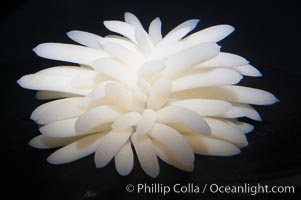
Squid egg casings. Each casing housings hundreds of tiny squid eggs. After the female squid has planted her egg casings to the sandy bottom, she will die.
Species: Common squid, Loligo opalescens
Image ID: 14931
Species: Common squid, Loligo opalescens
Image ID: 14931
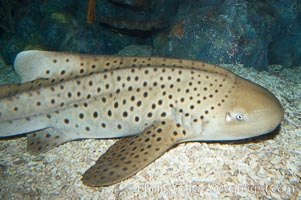
Zebra shark. The zebra shark feeds on mollusks, crabs, shrimps and small fishes. It can reach a length of 10 feet (3m).
Species: Zebra shark, Stegostoma fasciatum
Image ID: 14967
Species: Zebra shark, Stegostoma fasciatum
Image ID: 14967
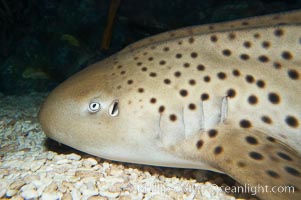
Zebra shark. The zebra shark feeds on mollusks, crabs, shrimps and small fishes. It can reach a length of 10 feet (3m).
Species: Zebra shark, Stegostoma fasciatum
Image ID: 14968
Species: Zebra shark, Stegostoma fasciatum
Image ID: 14968
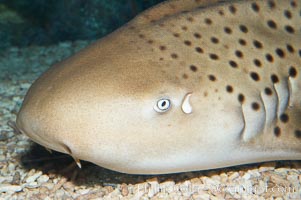
Zebra shark. The zebra shark feeds on mollusks, crabs, shrimps and small fishes. It can reach a length of 10 feet (3m).
Species: Zebra shark, Stegostoma fasciatum
Image ID: 14969
Species: Zebra shark, Stegostoma fasciatum
Image ID: 14969
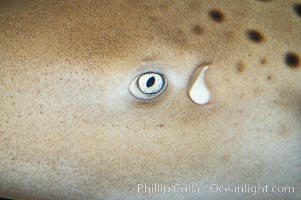
Zebra shark. The zebra shark feeds on mollusks, crabs, shrimps and small fishes. It can reach a length of 10 feet (3m).
Species: Zebra shark, Stegostoma fasciatum
Image ID: 14970
Species: Zebra shark, Stegostoma fasciatum
Image ID: 14970
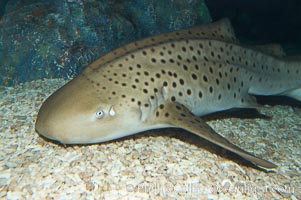
Zebra shark. The zebra shark feeds on mollusks, crabs, shrimps and small fishes. It can reach a length of 10 feet (3m).
Species: Zebra shark, Stegostoma fasciatum
Image ID: 14971
Species: Zebra shark, Stegostoma fasciatum
Image ID: 14971
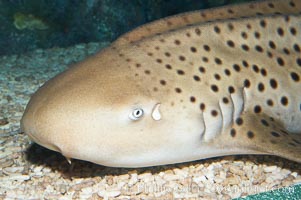
Zebra shark. The zebra shark feeds on mollusks, crabs, shrimps and small fishes. It can reach a length of 10 feet (3m).
Species: Zebra shark, Stegostoma fasciatum
Image ID: 14972
Species: Zebra shark, Stegostoma fasciatum
Image ID: 14972
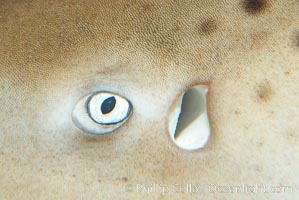
Zebra shark. The zebra shark feeds on mollusks, crabs, shrimps and small fishes. It can reach a length of 10 feet (3m).
Species: Zebra shark, Stegostoma fasciatum
Image ID: 14973
Species: Zebra shark, Stegostoma fasciatum
Image ID: 14973
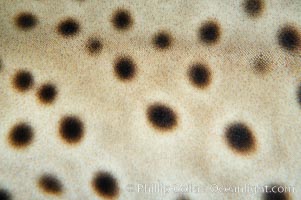
Zebra shark. The zebra shark feeds on mollusks, crabs, shrimps and small fishes. It can reach a length of 10 feet (3m).
Species: Zebra shark, Stegostoma fasciatum
Image ID: 14974
Species: Zebra shark, Stegostoma fasciatum
Image ID: 14974
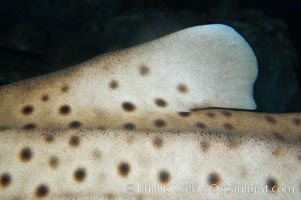
Zebra shark. The zebra shark feeds on mollusks, crabs, shrimps and small fishes. It can reach a length of 10 feet (3m).
Species: Zebra shark, Stegostoma fasciatum
Image ID: 14975
Species: Zebra shark, Stegostoma fasciatum
Image ID: 14975
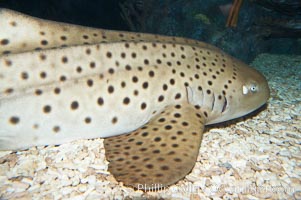
Zebra shark. The zebra shark feeds on mollusks, crabs, shrimps and small fishes. It can reach a length of 10 feet (3m).
Species: Zebra shark, Stegostoma fasciatum
Image ID: 14976
Species: Zebra shark, Stegostoma fasciatum
Image ID: 14976
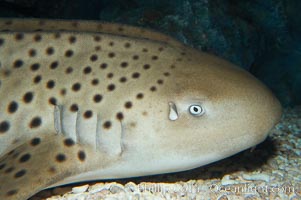
Zebra shark. The zebra shark feeds on mollusks, crabs, shrimps and small fishes. It can reach a length of 10 feet (3m).
Species: Zebra shark, Stegostoma fasciatum
Image ID: 14977
Species: Zebra shark, Stegostoma fasciatum
Image ID: 14977
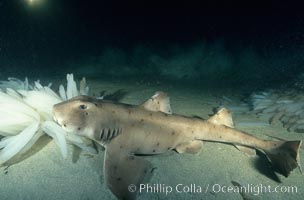
Horn shark eating opalescent squid eggs, Loligo opalescens.
Species: Horn shark, Heterodontus francisci
Location: La Jolla, California
Image ID: 01069
Species: Horn shark, Heterodontus francisci
Location: La Jolla, California
Image ID: 01069
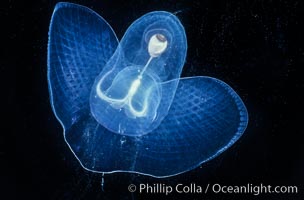
Pelagic opisthobranch or pteropod (wing foot), open ocean.
Species: Pteropod, Corolla calceola
Location: San Diego, California
Image ID: 01264
Species: Pteropod, Corolla calceola
Location: San Diego, California
Image ID: 01264
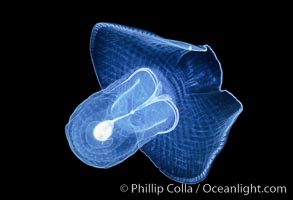
Pelagic opisthobranch or pteropod (wing foot), open ocean.
Species: Pteropod, Corolla calceola
Location: San Diego, California
Image ID: 02490
Species: Pteropod, Corolla calceola
Location: San Diego, California
Image ID: 02490
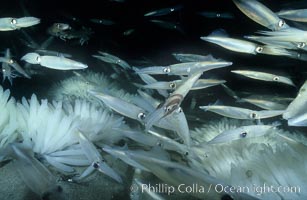
Squid mating and laying eggs, eggs on sandy bottom.
Species: Common squid, Loligo opalescens
Location: La Jolla, California
Image ID: 02547
Species: Common squid, Loligo opalescens
Location: La Jolla, California
Image ID: 02547
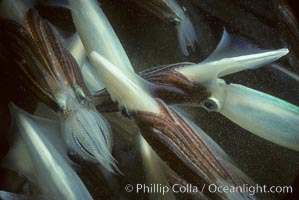
Squid, mating and laying eggs.
Species: Common squid, Loligo opalescens
Location: La Jolla, California
Image ID: 05379
Species: Common squid, Loligo opalescens
Location: La Jolla, California
Image ID: 05379
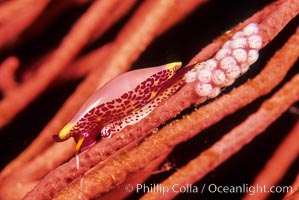
Simnia and egg cluster on gorgonian.
Species: Simnia, Delonovolva aequalis
Location: Anacapa Island, California
Image ID: 07025
Species: Simnia, Delonovolva aequalis
Location: Anacapa Island, California
Image ID: 07025
